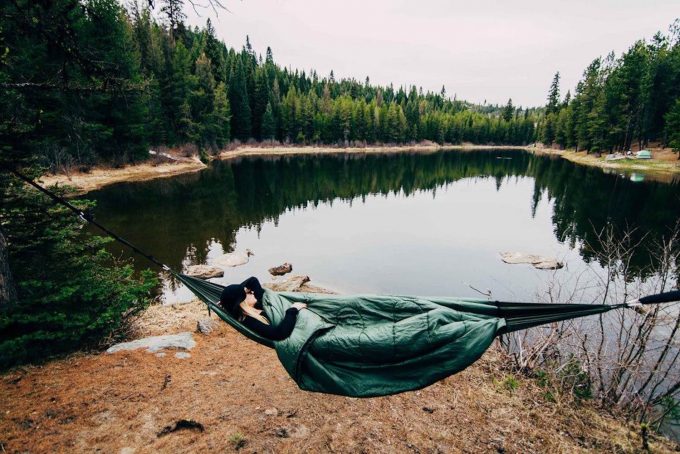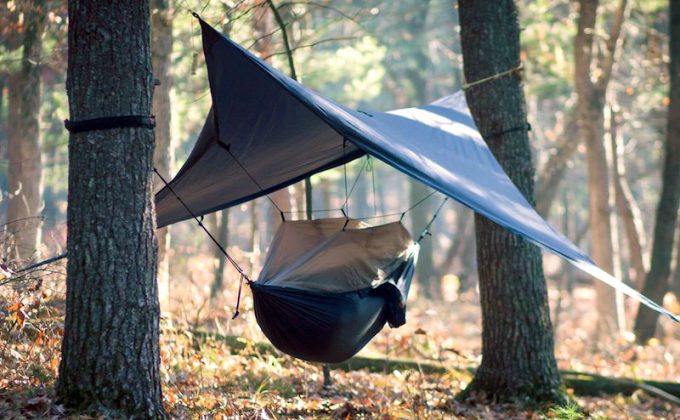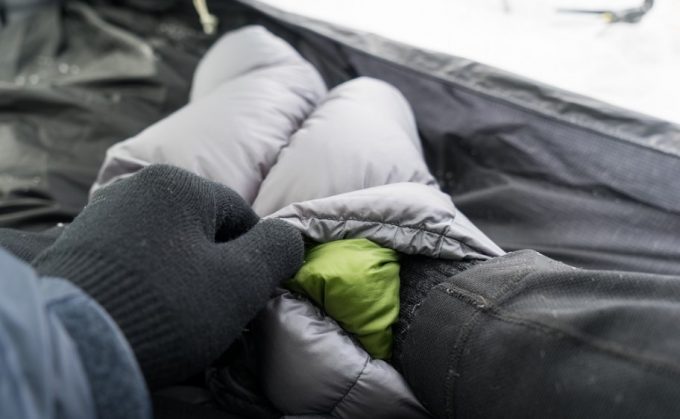Best Knots for Hammock Camping: What To Do And Knot To Do
On a warm summer day, almost nothing is better than relaxing outdoors, swinging back and forth in your favorite hammock. Whether you are setting up in your backyard or taking your hammock on the road to the great outdoors, you are going to want to attach it properly.
For first timers, it can be difficult to know which type of knot is best used when setting up, or even where to set up a hammock. There are many factors to consider, and like most camping gear, there are quite a few accessories to make you even more comfortable.

In this article, we are going to break down the best knots for hammock hanging, and cover a few other details about relaxing outdoors. Hammock camping helps you stay off the ground, lets you view the outdoor world and can be even more relaxing!
Whether you are planning a full nights sleep, or simply a place to swing, you will want to know how to hang up a hammock.
Thinking Outside the Tent
For most outdoor enthusiasts, hammock camping is a niche style of enjoying sleeping in the outdoor world. Sleeping this way can actually help some people sleep better! Sleeping on an ever so slight deflating mattress pad can be hard on the back, and for some, sleeping off the ground is essential.

If you have ever tossed in the night because of a missed rock, or gravel on the ground, or accidentally placed yourself on a slope, then you may be eager to forgo those problems by suspending. Once you have mastered how to tie a hammock to a tree, or any other standing object, you will be ready to sleep under the stars, in the fresh air!
See also: Best Knots for Hammock Camping: What To Do And Knot To Do
If you are still skeptical or wondering about cold weather camping, then check out some of the new hammocks specifically designed for camping. There are tarps, lofts, mosquito nets, and even rain flies, all to make cold weather camping easier. Hammock camping can also be a huge cost saver for the backpacker who wants to start out in solo light backpacking adventures. Check out our piece on the best hammocks with mosquito nets to guide you on your next adventure.

The gear tends to be on the less expensive size, and it packs down light and small. There are now books and forums dedicated to this style of camping, all enthusiastically discussing the health benefits, but also the joy of bringing a hammock along to the great outdoors.
Get Your Gear
Before we jump straight into tying the knot, we are going to first talk about what you will need to go hammock camping. This way you will not only have a comfortable trip, you will have all the tools necessary to support your weight on nearly any object.
You will first need to pick your hammock, which comes in a variety of sizes, fabrics, and durability. For camping, you will want to look for a roomy, water-resistant hammock to keep you warm and dry.
The width of the hammock needs to fit you, and perhaps a partner, if you pick out a hammock that is too wide it will wrap around you too much, and make you feel closed in.

Different hammocks also have different systems to hang up, this is also known as a suspension system. The three main systems are webbing, synthetic tree slings, and nylon ropes. See our review of the best outdoor ropes to help you in your choice.
When you look into the suspension system make sure that there are allot of attachment points, this will give you more flexibility when you go to set up your hammock in the great outdoors.
If you are buying the hammock for camping you are going to look for lightweight nylons, these will help insulate you without cutting off all that fresh air.

Most hammock campers will suggest also bringing along tree straps or some form of webbing if it is not built into your suspension system. When you are attaching your hammock between two trees using bare rope can dig into the bark, and cause the tree stress and damage. To avoid this, you use a tree hugger strap.
If you don’t have straps, you can still set up your hammock outside using the knots we explain down below. Make sure the straps you purchase are wider than 0.75 inches, any narrower and you will damage the tree.
If you are planning on your set up to have rope, you are going to want to pick the right one. Nylon ropes can be very stretchy, which you want to avoid. An overly stretchy rope will leave your hammock sagging and will ruin your good night’s sleep.
If you choose to avoid nylon, you are left with natural fiber ropes, which won’t stretch at night, but will swell when wet. This means that when the rope swells, it tightens, also changing your sleeping position.

Regardless of which you choose, calculate that into your final placement. Pick your rope based on the weight it needs to support and its flexibility.
Specs for your Knot
Now that you know the type of gear you need, you are ready to make a knot! There are a few specifications to look for in a good hammock hanging knot. You want it to have three major things for a comfortable night’s sleep. First, you will want to make sure that the knot can handle the load or the net weight of yourself and the hammock.
Next, you will want to make sure that the knot is easy to adjust so that you can either tighten or loosen the hammock for a comfortable sleeping position.
Finally, it needs to be easily untied after you are done with, some knots get tighter with weight, making it difficult to undo. If a knot has all three of these specifications, then it is going to be perfect for your night under the stars.
The Marlinespike Hitch
For this particular knot, you will need to bring along a carabineer. This knot is incredibly easy to create, will stay intact throughout the night, and is a fan favorite for those who like the added security of the carabineer.

The downside is that it is not very adjustable and that if you forget your carabineer you can’t use the knot.
- Take the rope and wrap it around the tree.
- Twist the rope to form a loop, and then fold that loop up, the upper strand should be visible through the loop.
- Pull the upper strand through the first loop.
- Clip the carabiner through the loop you just formed and connect it to the hammocks eye.
The Beckett Knot
This is the best go-to knot for hammocks, it is both simple and quick to put up. It requires no extra hardware to attach, meaning no straps or webbing, and it’s easily adjustable. All this means that you can put it up fast and tweak it for the perfect sleep.

Below is a step by step how to:
- Start with wrapping your rope around the tree to secure the line.
- Take the end of the rope, and put it through the ‘eye’ of your hammock, the loop at each end
- Once through, bring the end of the rope around the back of the eye and then under its own standing part.
- Tighten the knot down
Perfect Position
If you find yourself still restless and uncomfortable, even in the hammock, it could be that you haven’t adjusted your ropes quite right. Like any type of sleeping device, it’s going to be based on your own personal preference, but also the level of support you need. You will want to get a flat lay when setting up.
Hanging up a hammock goes against basic logic, most people think that the tighter they hang it the flatter it will be, which isn’t necessarily true.
Tighter hammocks mean your body is pulling the sides around you, and they will raise up above your head too far. Setting it up too tight will also squeeze your shoulders and potentially harm the tree! Start with plenty of slack when you get the hammock up.

You are going to sleep in the hammock at a 30-degree angle, essentially lying on a diagonal line. This will cut the curvy hammock giving you a flat lay. Your neck and feet will be slightly elevated, and there will be no pressure points about your back. What’s best about laying down this way is that you can shift around as much as you like, and sleep in any position!
If you have bought a hammock that is the right size for you, then you shouldn’t worry about flipping, so move around as much as you’d like. This is the safest and most comfortable way to get a good night’s sleep!
Accessories
Much like all camping gear, hammocks come with plenty of accessories to help you stay warm, dry, and comfortable. If you don’t plan on camping in a warm tropical location, then you are going to want to bring along a few additional items. A sleeping bag, preferably a well insulates mummy bag, and a pad will be the perfect combination. You need to pad to protect you from the chilly air and the wind.
The pad doesn’t have to be state of the art, you can buy a cheap foam pad for your setup, as it’s not protecting you from the ground, only the air! For the best down sleeping bags for outdoor camping, see our previous piece for reference.

What some people hate about camping in a hammock is the fear of getting bit and attacked by mosquitos and other insects. Tents do an excellent job protecting you, and even though a hammock doesn’t do quite the same level of protection, there are nets made for your system! Some will give you 360-degree protection, the hammock slips inside the netting and is velcroed or zipped for security.
Others require you to set up a ridgeline above the hammock and let the netting or covering fall to the side. Some bugs are really persistent, so if you are going to a mosquito hub, consider buying the heavier dual layered hammock. Some bugs will bite you straight through the fabric!
If you are wondering how hammocks work even in cold weather, then there are accessories for that too! Rain flies help you avoid collecting water and moisture on the inside, and listening to rain tap on your material can actually be pleasant. Nowadays there are rainfly made specifically for hammock camping.
You will be able to tell that they are made for you if they are made from silnylon, which is lighter than an average tarp, but still incredibly strong and waterproof. Simply create a ridgeline above the hammock, and suspend the tarp. Much like a tent, guylines pull the tarp down to the sides and lock them in place.

If you are planning on extreme weather, there are shelters designed, that have zipped doors and encased fully. Essentially you have a floating tent with these shelters!
Picking your Tree
Now that you have your full setup, you are ready to go camping and find your perfect spot. With a sturdy suspension system, you can place yourself almost anywhere, but we have a few tips to pick your trees, and ultimately how to hang your hammock.
Your trees should have a few characteristics, perhaps most importantly they should be about five paces apart. Plenty of room for a loosely hung hammock and the length of your body.
You will then need to check the trees themselves. Look up, if you see any dead branches above you then you have not picked the right spot. Dead branches can and will fall on you, and with enough speed and weight, they can be deadly.

Now check below you, is there a lot of brush and plants that could poke you or make it difficult to set up? And finally, how wide are the trees, you are going to be looking for sturdy trees to sustain your weight the whole night. Look for trees that have a foot-long diameter, or longer.
*Helpful tip: If you are struggling to find a good distance for your hammock, use your trekking poles. Stand in the center and extend the poles out both sides, if they hit the tree, then they are too close together.
Lean slightly to the left, if it hits the tree that’s a good distance, repeat the same with the tree to the right.
Safety
What most people don’t immediately think of when they go hammock camping, is the different safety requirements they need to consider.
We’ve mentioned a few above, but here is a list of top safety concerns before you go:
- Is there any dead tree branches above you, they could fall and seriously injure or kill you, these branches are referred to as widow makers. Dead branches can be seen by their color, lack of leaves, or a lot of spider activity.
- Is the tree itself showing signs of rotting, it could collapse during your nap or sleep, and cause you serious harm.
- Check your gear, if you are using ropes, make sure they are in a sturdy condition with no sign of wear.
- Check your hammock, if it has any damage, or is showing signs of molding it is not suitable to use.
- Falls are unlikely, however, if you do slip out make sure that the ground below you are free of any hazards, like large rocks
- In the same idea of falling, hammocks that are too far off the ground can look cool but it makes getting in and out dangerous. You do not need to be more than a foot off the ground to be comfortable.
- While there are bug nets, try and camp in places with low insect activity, especially mosquitos. Hungry bugs will bite their way through fabrics to get to you, and some of them do carry diseases. In addition, spray the outside of your hammock with bug repellent to help with any bug irritations.

Ready to Float
Now that you have all your equipment, and know how to attach your ropes onto a tree, you are pretty much ready to hammock camp. Hikers, campers, and loungers alike love hammock camping, as it is not just a sleep system, it is also a place to relax, and enjoy a sunny day while backpacking.

When you decide to pick your spot, make sure to look for sturdy trees, that are far enough apart, and while it may be tempting to be up high, it’s safer staying closer to the ground. Hammock camping offers a lightweight and less expensive option. This style of camping can be better on your back and gives you a gorgeous view of the night stars. For more tips on how to tie knots, see our earlier article on this topic.
Regardless of the weather, you can enjoy a nice rock in a hammock, and can even share them with your partner or family, just like a tent!
Have you been out camping in a hammock, or have a better knot to use? Let us know in the comments below!






